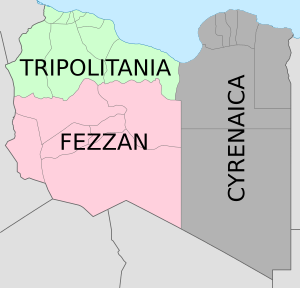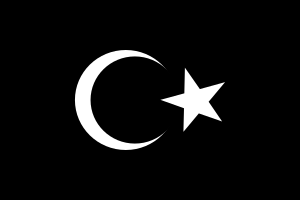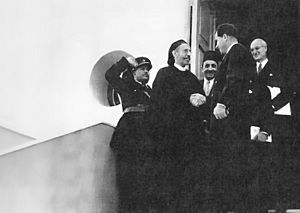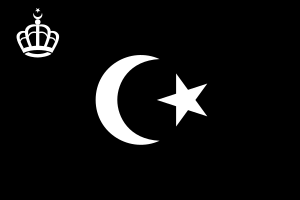Idris of Libya facts for kids
Quick facts for kids Idris |
|||||
|---|---|---|---|---|---|

King Idris in 1960
|
|||||
| King of Libya | |||||
| Reign | 24 December 1951 – 1 September 1969 | ||||
| Heir apparent | Hasan | ||||
| Prime ministers |
See list
Mahmud al-Muntasir
Muhammad Sakizli Mustafa Ben Halim Abdul Majid Kubar Muhammad Osman Said Mohieddin Fikini Hussein Maziq Abdul Qadir al-Badri Abdul Hamid al-Bakkoush Wanis al-Qaddafi |
||||
| Born | 13 March 1890 Al-Jaghbub, Tripolitania Vilayet, Ottoman Empire |
||||
| Died | 25 May 1983 (aged 93) Cairo, Egypt |
||||
| Burial | Al-Baqi' Cemetery, Medina, Saudi Arabia | ||||
| Spouse |
Sakina bint Muhammad as-Sharif al-Sanussi
(m. 1907; div. 1922)Nafisa bint Ahmad Abu al-Qasim al-Isawi
(m. 1911; div. 1915)Fatima el-Sharif
(m. 1931)Aliya Khanum Effendi
(m. 1955; div. 1958) |
||||
|
|||||
| House | Senussi | ||||
| Father | Muhammad al-Mahdi as-Senussi | ||||
| Mother | Aisha bint Muqarrib al-Barasa | ||||
| Religion | Sunni Islam | ||||
Muhammad Idris bin Muhammad al-Mahdi as-Senussi (also known as Idris; born March 13, 1890 – died May 25, 1983) was an important political and religious leader from Libya. He became the first and only King of Libya on December 24, 1951. He ruled until September 1, 1969, when he was removed from power.
Before becoming king, Idris was the Emir (a type of ruler) of Cyrenaica and Tripolitania starting in the 1920s. He was also the head of the Senussi Muslim group. This group played a big role in his early life and rise to power.
Idris helped end fighting between his group and the British and Italians during the Senussi campaign. After World War II, the United Nations General Assembly decided that Libya should become an independent country. They united three regions—Cyrenaica, Tripolitania, and Fezzan—to form the United Kingdom of Libya, and Idris was chosen to be its king.
As king, Idris had a lot of power. He banned political parties and changed Libya's government system. He also made friends with Western countries like the United Kingdom and the United States. This allowed them to build military bases in Libya, and in return, Libya received economic help. When oil was found in Libya in 1959, he helped develop the oil industry, which made the country much richer. However, his rule faced challenges from people who wanted Libya to be more independent and less connected to Western nations. There were also concerns about unfair practices in the government. While Idris was away for medical treatment, army officers led by Muammar Gaddafi took over the country in 1969.
Contents
Early Life and Becoming a Leader
Idris was born in Al-Jaghbub, which was the main center for the Senussi movement. His grandfather, Muhammad ibn Ali as-Senussi, founded the Senussi Muslim group in North Africa. This group was a religious movement that aimed to bring back traditional Islamic practices. They were mostly based in Cyrenaica, a region in eastern Libya.
In 1916, Idris became the leader of the Senussi group. This happened after his cousin, Ahmed Sharif as-Senussi, stepped down. The British recognized Idris as the "emir" of Cyrenaica, and the Italians also agreed to this in 1920. He later became Emir of Tripolitania in 1922.
Leading the Senussi Order: 1916–1922
When the Italian army invaded Cyrenaica in 1913, the Senussi Order fought against them. After Idris became leader, he stopped the attacks against British forces in nearby Egypt. Instead, he formed a quiet agreement with the British Empire. This agreement helped his group gain a special diplomatic status.
Idris then started talks with the Italians in 1916. These talks led to agreements that left most of inland Cyrenaica under the control of the Senussi Order. However, relations between the Senussi and the Tripolitanian Republic were not good. The Senussi tried to expand their power into eastern Tripolitania, but they were forced to retreat.
After World War I, the Ottoman Empire gave up its claims over Libya to Italy. Italy was facing its own problems and wasn't ready to restart military actions in Libya. So, they created laws that gave Libyans the right to be both Libyan and Italian citizens. Each province would also have its own parliament. Idris and the Senussi were mostly happy with this plan.
In 1920, more talks between Italy and Cyrenaica led to the Accord of al-Rajma. This agreement gave Idris the title of Emir of Cyrenaica. It also allowed him to govern certain oasis areas on his own. The Italian government even gave him a monthly payment. However, Idris did not fully follow all parts of the agreement, like disbanding his military units. By the end of 1921, relations with Italy worsened again.
After a leader in Tripolitania died in 1920, the region fell into civil war. Many tribal leaders wanted stability and asked Idris to extend his rule into Tripolitania. Idris's advisors were split on what to do, as it would go against his agreement with Italy. But in November 1922, Idris agreed to the proposal.
Years in Exile: 1922–1951
After agreeing to rule Tripolitania, Emir Idris worried that Italy, now led by Benito Mussolini and his Fascist party, would attack the Senussi Order. So, in December 1922, he went into exile in Egypt. Soon after, Italy began to take back control of Libya by force. Many Libyans were put in camps, and thousands were killed. Italy also moved many of its own citizens to Libya to start farms.
When World War II started in 1939, Idris supported the United Kingdom, which was fighting Italy. He hoped this would help free Libya from Italian rule. He believed that even if Italy won, Libya's situation would not improve. Idris suggested that Libya become a British protectorate, similar to Transjordan. A group of Libyan volunteers was formed to help the British war effort.
After Italy was defeated, British and French forces controlled Libya. They governed the area until 1949. In 1946, a group called the National Congress was formed to prepare for independence. This group was mostly made up of members of the Senussi Order. In 1947, Italy gave up its claim to Libya.
The European powers then suggested a plan where France would control Fezzan, the UK would control Cyrenaica, and Italy would control Tripolitania for ten years. When this plan was announced in 1949, it caused protests in Libya and was opposed by the United States and the Soviet Union. The United Nations General Assembly rejected this plan and supported full independence for Libya.
In November 1949, the UN General Assembly passed a resolution for Libya to become independent by January 1952. The resolution stated that Libya should be a single country led by Idris as king. Idris was hesitant to accept this role. Both the United Kingdom and the United States supported this plan because they wanted to prevent the Soviet Union from gaining influence in the region. They knew they could build military bases in an independent Libya that was friendly to them.
King of Libya: 1951–1969
On December 24, 1951, Idris announced the creation of the United Kingdom of Libya. This happened at the al-Manar Palace in Benghazi. At the time, Libya had about one million people, mostly Arabs, but also other groups like Berbers and Italians. The new country faced many challenges. In 1951, Libya was one of the poorest countries in the world. Much of its buildings and roads were destroyed by war, and most people could not read or write.
The Kingdom was set up as a federal system. This meant that the three provinces (Cyrenaica, Tripolitania, and Fezzan) had their own local governments. Cyrenaica and Fezzan wanted this system because they feared being controlled by Tripolitania, where most of the population lived. However, Tripolitanians wanted a single, strong central government. This federal system made it hard for the central government to make decisions for the whole country. Benghazi and Tripoli were made joint capital cities.
King Idris was officially a constitutional monarch, meaning his power was limited by a constitution. However, in practice, he had a lot of personal power. He made many important decisions for the country. Idris was a very religious Muslim and did not want his picture on Libyan money. He also insisted that nothing should be named after him except the Tripoli airport.
His government soon banned political parties, saying they caused instability. From 1952, only candidates chosen by the government could run in elections. In 1954, the Prime Minister suggested changing Libya from a federal system to a single, unified state. Idris liked this idea because it would solve problems caused by the federal system. However, the idea was dropped due to opposition from tribal leaders in Cyrenaica.
Under King Idris, Libya became close to Western countries. It received a lot of help and money from the United States. In return, Libya allowed the United States and the United Kingdom to use military bases in the country. This closeness to Western nations caused some tension in Libya, as many people in the Arab world supported Arab nationalism. In 1967, there were protests in Tripoli and Benghazi against Western support for Israel during the Six-Day War.
Oil Discovery and Economic Growth
In the 1950s, companies began looking for oil in Libya. In 1959, oil was discovered. This discovery brought a huge boost to Libya's economy. Before oil, the average income per person was very low. By 1969, it had grown significantly. Libya quickly became one of the world's largest oil producers. In 1962, Libya joined OPEC, an organization of oil-exporting countries. The Libyan government also took more control over the oil industry, creating its own oil companies.
Despite the economic growth, there were problems with unfair practices and favoritism in the government. In 1960, King Idris publicly spoke out against these issues, saying they would harm the country.
On April 26, 1963, King Idris changed Libya's federal system. He abolished the provincial assemblies and judicial systems. This allowed him to centralize economic and administrative planning. From then on, all taxes and oil money went directly to the central government. As part of this change, the "United Kingdom of Libya" was renamed the "Kingdom of Libya." This change gave Idris much more political power. By the mid-1960s, Idris began to step back from daily governance.
Overthrow and Exile
King Idris used the oil money to strengthen his family and tribal connections that supported the monarchy. He was not very interested in ruling the three provinces as a truly unified country. His government had little support outside of Cyrenaica. It was weakened by unfair practices and growing Arab nationalist feelings, especially after the 1967 Six-Day War.
On September 1, 1969, while King Idris was in Turkey for medical treatment, a group of Libyan Army officers led by Muammar Gaddafi took over the country in a coup d'état. The monarchy was ended, and a republic was declared. This coup happened just before King Idris planned to step down and let his heir take over. From Turkey, he and the Queen traveled to Greece and then went into exile in Egypt.
After the 1969 coup, King Idris was put on trial in Libya while he was not there. He was found guilty in November 1971. Muammar Gaddafi's government often said that King Idris's rule was weak, unfair, and not truly nationalist.
In 1983, King Idris died in a hospital in Cairo, Egypt, at the age of 93. He was buried in Al-Baqi' Cemetery in Medina, Saudi Arabia.
Legacy and Personal Life
Historians describe King Idris as a thoughtful person who was not eager to be involved in politics. He was seen as a well-meaning but hesitant ruler, a religious and humble man. One of his Prime Ministers said that Idris truly wanted reforms but would hesitate if they affected his close circle of advisors.
King Idris had several marriages. He and his wife Fatima adopted a daughter named Suleima, who was an orphan from Algeria.
During the 2011 Libyan Civil War, many people protesting against Gaddafi carried pictures of King Idris, especially in Cyrenaica. The old flag used during the monarchy was also used as a symbol of the revolution and was later adopted as the official flag of Libya.
Honours
Idris was the grand master of several Libyan orders, which are like special awards or groups of honor. These included:
He also received many honors from other countries, such as:
Honorary Knight Grand Cross of the Order of the British Empire from the United Kingdom (1954)
 Grand Cross of the Legion of Honour from France
Grand Cross of the Legion of Honour from France Grand Cross of the Order of Merit of the Italian Republic from Italy
Grand Cross of the Order of Merit of the Italian Republic from Italy
Images for kids
See also
 In Spanish: Idrís I de Libia para niños
In Spanish: Idrís I de Libia para niños







